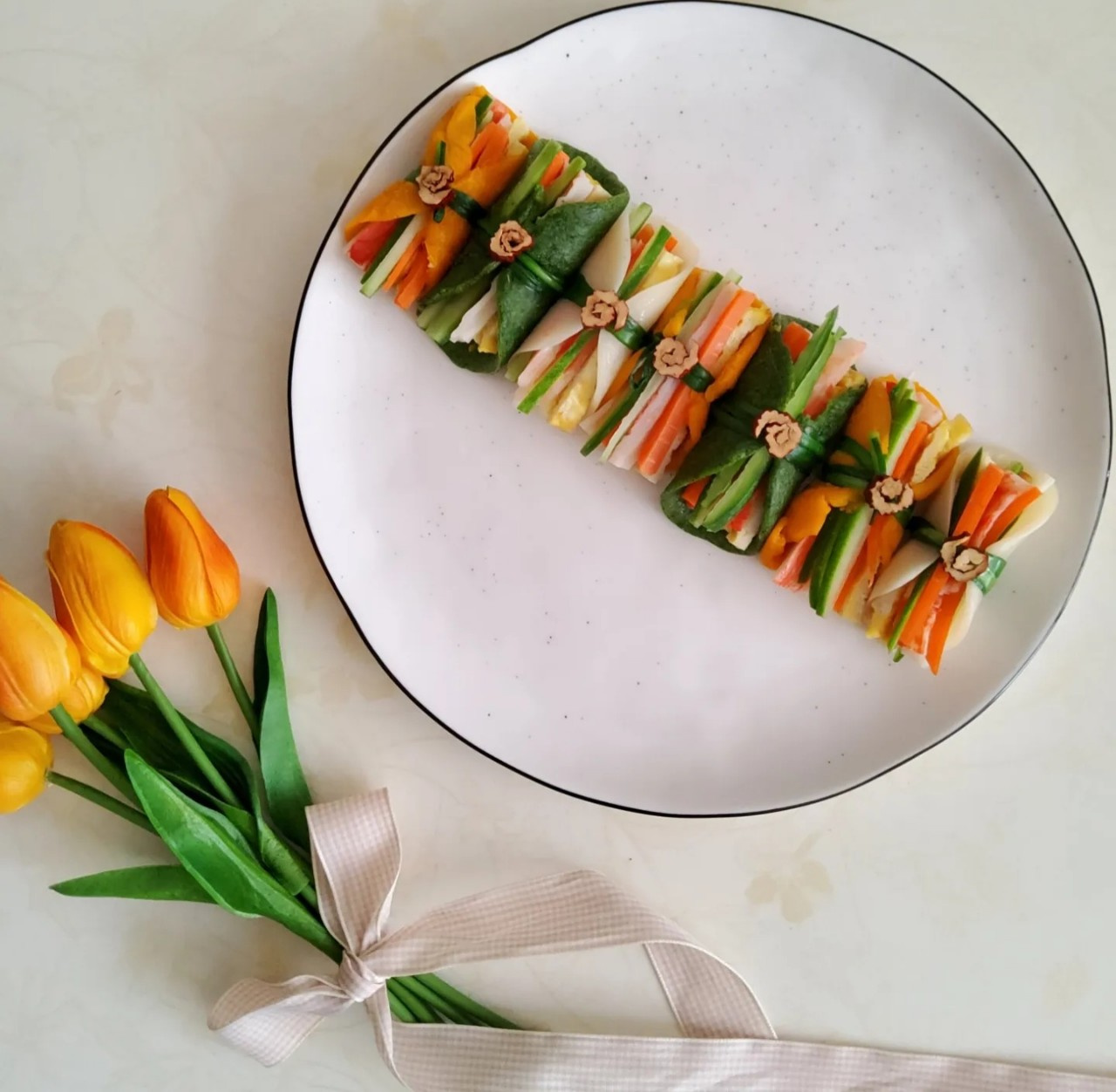Three-Color Miljeonbyeong (Korean Crepes)
[2022 Traditional Food Recipe Contest] Beautiful Three-Color Miljeonbyeong

Miljeonbyeong, also known as Gujeolpan, is a quintessential Korean traditional dish. It’s a dish that one cherishes and savors, often prepared for special occasions like parents’ birthdays, where its visual appeal is almost too beautiful to eat! This recipe is inspired by the ‘Tteok Yagi’ (Stories of Rice Cakes) from Joseon scholar Seo You-gu’s ‘Imwon Gyeongjeji’, and I wanted to introduce this beloved traditional Korean food, Miljeonbyeong (Gujeolpan), to a wider audience. While traditional cuisine can seem daunting and vast, I saw this as a wonderful challenge to recreate an ancient recipe with modern flair. Since food is also enjoyed with the eyes, Miljeonbyeong stands out not only for its nutritional value, texture, and taste but also for its vibrant presentation. This recipe offers a simple and accessible way to enjoy this traditional delicacy, proving that it’s not as difficult as it might seem. It’s a perfect dish for a special meal, offering both nourishment and delightful flavors.
Vegetables and Garnish- Spinach 50g
- Cucumber 1/4
- Carrot 1/4
- Chives (a small bunch)
- Crab stick 1/4 piece
- Jujubes (dates) 2
Cooking Instructions
Step 1
Today, we will be making Miljeonbyeong, a beautiful traditional Korean dish boasting vibrant colors and a medley of delicious fillings.

Step 2
First, let’s prepare the fillings for the Miljeonbyeong. Wash the cucumber thoroughly and use a peeler to remove only the skin, discarding the inner seedy part. Thinly julienne the cucumber peel. Julienne the carrot into similar lengths. For the eggs, make thin omelets (jidan), let them cool, and then julienne them to match the length of the cucumber and carrot. Prepare the crab stick by cutting it into similar lengths.

Step 3
To make the spinach batter, wash the fresh spinach leaves. Briefly blanch them in boiling water for about 30 seconds to retain their vibrant green color, then immediately rinse in cold water and squeeze out excess moisture. Place the blanched spinach in a blender with a very small amount of water and blend until smooth. This will give the batter a rich, beautiful green hue.

Step 4
Gradually add flour to the pureed spinach, mixing as you go to form a batter. The consistency should be thin enough to spread easily on the pan but not so watery that it becomes difficult to handle. Aim for a consistency where the batter flows slowly off a chopstick.

Step 5
For the sweet pumpkin batter, steam or boil the sweet pumpkin until tender (about 5-7 minutes for steaming, 5 minutes for boiling). Once cooked, remove the seeds and peel. Place the pumpkin flesh in a blender with just a tiny bit of water and blend until smooth. The pumpkin’s natural moisture might be sufficient, so adjust water as needed.

Step 6
Add flour gradually to the pureed sweet pumpkin, mixing to create a batter. Similar to the spinach batter, aim for a consistency that allows for thin crepes on the pan. It should fall slowly from a chopstick.

Step 7
For the plain flour batter, gradually add water to the flour until you achieve a thin batter suitable for making crepes. It’s a good idea to add a pinch of salt to this batter for seasoning. Now you have three colorful batters ready! If you prefer, you can add a little sugar instead of salt.

Step 8
Now, let’s cook the Miljeonbyeong. Lightly grease a non-stick pan over low heat with a thin layer of cooking oil. Pour a ladleful of the sweet pumpkin batter into the center of the pan and swirl the pan to create a thin, round crepe. Once the edges start to lift slightly, don’t flip it. Instead, place the prepared fillings on top. Arrange a few chives along the edge of the pan, then layer the julienned cucumber, carrot, crab stick, and egg jidan over the sweet pumpkin batter. Tilt the pan slightly to help the batter cook, then carefully roll the fillings up tightly, like making a sushi roll. Cook briefly on the pan to set the shape. You can serve them rolled like this, or cut them into pieces later.

Step 9
Next, use the spinach batter to make another Miljeonbyeong. Lightly grease the pan and pour the spinach batter, spreading it thinly. Once slightly cooked, arrange chives along the edge, followed by the cucumber, carrot, crab stick, and egg jidan. Roll it up tightly, just like you did with the sweet pumpkin version.

Step 10
Finally, use the plain flour batter to create the last Miljeonbyeong. Lightly grease the pan and spread the plain batter thinly. To ensure the fillings stay put and for a neater presentation, you can place chives along the edge first, then layer the cucumber, carrot, crab stick, and egg jidan, and roll it up tightly. You now have three colorful Miljeonbyeong rolls. Ensure they are rolled firmly like kimbap.

Step 11
Arrange the finished three-color Miljeonbyeong attractively on a serving plate. To add a beautiful garnish, remove the pits from the jujubes, slice them thinly into rounds, and shape them into ‘jujube flowers’. Place these delicate flowers on top of the Miljeonbyeong. Slice the rolled Miljeonbyeong into bite-sized pieces for serving.

Step 12
The combination of vibrant colors and fresh ingredients makes this traditional Korean Miljeonbyeong a truly special dish. It’s perfect not only for parents’ birthdays but also as an impressive appetizer or side dish for guests. The fun of choosing different colors makes it even more enjoyable to eat.

Step 13
As the saying goes, we eat with our eyes first. Gift happiness and gratitude to your loved ones with these beautifully crafted three-color Miljeonbyeong. For more details, please visit the Naver blog: https://m.blog.naver.com/ja8072/222938735733




